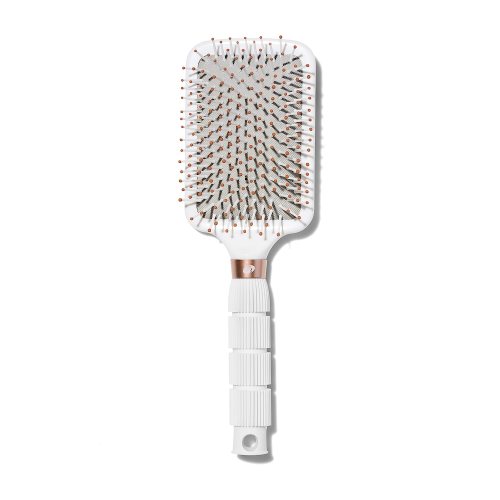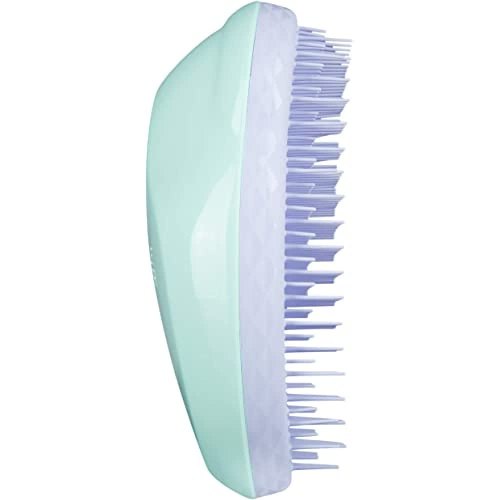Our editors independently select these products. Making a purchase through our links may earn Well+Good a commission
3 Common Hair Brushing Mistakes a Stylist Says Are Causing Major, Unnecessary Breakage
Making any of these detangling mistakes can cause more pain and breakage than necessary. Learn what not to do and the better alternatives.

Every time I detangle my hair, I’m convived I’m ripping out half of my strands. Because I have coily, 4C hair and don’t detangle that often, I know that when I do decide to do it that I’m brushing out days’ worth of natural shedding—and the mound of hair that I collect with each session is somewhat alarming. According to Tippi Shorter, global artistic director at Mizani and celebrity hairstylist, I’ve been making one major detangling mistake: using a wide-tooth comb.
Experts in This Article
celebrity hairstylist and artistic director for Mizani
“I don’t use combs. I haven’t used a comb to detangle since the ’90s,” says Shorter, who is based in Kansas City, Missouri. “Combs don’t have any give. So if you’re coming across a tangle, it’s just ripping through it, whereas a brush will glide through that tangle.”
Although a comb can effectively detangle, it does so at the cost of your hair, causing more pain and breakage than necessary. While this was the most shocking revelation of our call, Shorter also shared two other common detangling mistakes that she wants you to avoid.
3 detangling mistakes to avoid and cut down on breakage
1. Detangling with a comb
Instead of using a comb, Shorter says you should always use a detangling brush and ensure you’ve got the right one for your hair type. “Choosing the right tool for your hair type is almost as important as the product you use to detangle,” she says.
For medium to thick hair, Shorter says to use a firm-bristled brush.
“The thicker and coarser of the hair, the firmer you want your bristles to be on your detangling brush,” she says. “One of my favorite brushes to detangle medium-to-thick hair is the T3 Paddle Brush ($35). It’s cushioned, but the bristles have a little give, so they’re not super duper firm. If there is a tangle or something, it will wrap around the tangle versus comb through the tangle.”

T3, Smooth Paddle Brush — $35.00
For thin, fine hair, she loves going in with just her fingers or a super flexible brush.
“A person with fine hair shouldn’t use a paddle brush or something that has more firm brittles because you don’t need all that tension going through fine or thin hair,” she says. “If you have thinner hair, you can use your fingers almost like a rake to detangle or use a brush that has very maneuverable bristles. So if you run your thumb through the bristles, they almost flex as easily as a broom bristle.”
Her go-to detangling brush for fine hair is the handle-free Tangle Teezer Fine & Fragile ($13). It has two tiers of soft-flex teeth that are 30 percent softer than the original Tangle Teezer to glide from root to tip with no pulling and less breakage.

Tangle Teezer, Fine & Fragile — $13.00
2. Wetting knotted hair
It’s often best to detangle textured hair during the conditioner stage of your wash day because the water and product make it easier to glide through tangles without breakage. But if you’ve got straight-up knots, wetting them will make them harder to remove.
“The only time I detangle before shampooing is if there are knots present—you don’t want to start wetting hair that already has knots in it because that’s just going to create larger knots,” says Shorter.
Instead of dampening your knots with water, Shorter recommends saturating them with a product to provide some slip. “The hair always needs to be slippery for it to be detangled with ease and without breakage,” she says. Her go-to’s for detangling are the Mizani 25 Miracle Milk ($25) and the Mizani 25 Miracle Cream ($25), two leave-in products that work on different hair textures.
“I love the 25 Miracle Milk. It’s a liquid, so it’s fantastic for finer hair that’s a little thinner,” says Shorter, adding that it’s also great for thick, straight hair as it won’t weigh it down or make it look limp. “For thicker curls, I like the sister version of this product, which is a cream instead of a milk. So it’s a thicker consistency, but it still has those 25 essential oils.”

Mizani, 25 Miracle Milk — $25.00

Mizani, 25 Miracle Cream — $25.00
3. Trying to start detangling at the scalp
It would be glorious to be able to start at your root and slide your brush down to your ends in a flash, but tangled hair doesn’t work that way—your brush will likely get stuck before it makes it halfway down the hair shaft. So make sure you start detangling from the ends of your hair and work your way up.
“I like to grip the hair midway through and then staring my detangling at the end and releasing any tangles there,” says Shorter. “And then I move up, releasing any tangles there, and then I just keep moving up until I’m brushing the roots.”
Sign up for the Well+Good SHOP Newsletter
Get exclusive deals on wellness, beauty, fitness, and food products that have been hand-picked by our editors.
Got it, you've been added to our email list.










